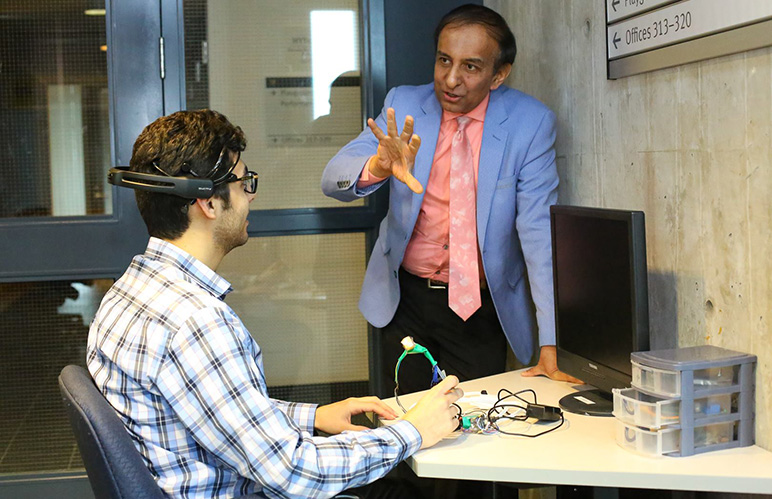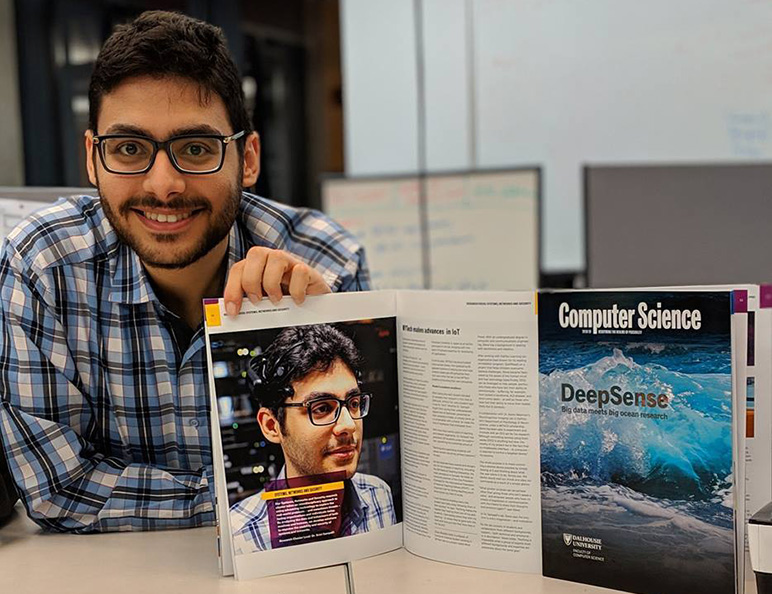RHU is more than proud of its computer and communications engineering graduate, Mr. Steve Mostafa Dafer. One of the by-products of his research is the “Mind Power” solution, developing a means to communicate with people who have lost control over their body? Although controlling devices by using brain waves (EEG) is anything but new, the novelty of his project lies in the fact that no middleware interface (i.e. computer) is required to control a targeted device; the whole purpose is to make controlling a desired device possible by simply looking at it and thinking about what the user wants it to do.
Simply put, devices can read the mind and obey its commands as a result of a simple glance. The project was in collaboration with Dal’s neurology lab under the MITACS program. Given the diversity of fields tackled at MYTech Lab, they got their hands on an EEG headset to toy with!

Mr. Dafer is investing his time in his research project that goes further by allowing even patients with locked-in syndrome- a state similar to coma where the patient is aware of the surroundings, but cannot move his body nor indicate approval nor rejection - to be able not only to control devices, but also type at a rate at least twice as fast as that provided through Stephen Hawking’s system (developed by Intel and SwiftKey); the system utilizes machine learning algorithms and provides a highly customized scanning keyboard that is the result of years of research.
“Having worked with Halifax Learning Center on a project that helps children overcome dyslexia challenges, I was fascinated by the power of the human mind and how technology (namely EEG) can be leveraged to help the unfortunate who have either lost the ability to move freely (e.g. Paralyzed) or even who suffer from the locked-in syndrome, where the brain is fully functional, so they can think and feel but they've lost all means of communication (e.g. full paralysis, ALS disease and some coma cases); such cases are on the rise due to several factors such as car accidents,” Dafer says.

We are talking about people, who are completely capable of thinking and understanding their surroundings but have lost all means of voluntary control over their muscles, a case that is becoming more popular, unfortunately, due to the increasing cases of car accidents for example. Such patients may lose control over some body parts or even become completely paralyzed. It is worth mentioning that we have recently discovered that some coma-state patients are aware of their surrounding and should not be deemed almost-dead as previously thought; this achievement wouldn’t have seen the light without the advancements in brain scanning and analysis techniques.
The platform empowers such patients with the ability to make live phone calls! Imagine enabling someone who can’t even speak to make a seamless phone call! The project covers all aspects of the solution; it’s innovative not only in terms of software, but also in terms of hardware where a new type of sensor is being used for improved comfortability and accuracy.
While it is true that technology has improved drastically and that now we are able to communicate with such cases where only one input method is available, even when no muscles can be moved at all (i.e. Using brain waves EEG), we are concerned with the rate of typing that limits the patient’s means of communication. It’s said that Stephen Hawking was able to type at an average rate of one word per minute, that’s a whole five minutes for a single short sentence. It is also worth mentioning that Hawking did not actually type the whole word; natural language processing algorithms are estimated to have guessed the correct word after the second or third letter. Imagine how much more books and theories Hawking might have been able to potentially produce had he had the means to faster communication abilities.
One can easily imagine how the story of a scientist such as that of Stephen Hawking could have ended, hadn’t it been for the technology that empowered him with the ability to share his thoughts. Stephen Hawking was not only able to help us understand physics better, he even wrote books and published his theories by controlling a single muscle, or a group of muscles that acted as a single input method. And what greater purpose can we achieve other than giving those who can’t speak a voice, and empower people who have no means of expression or communication with the means to “live” and share their thoughts and emotions again?
Mr. Mostafa Dafer is currently pursuing his master’s degree at Dalhousie University in Canada.